2. 中国地质大学地质过程与矿产资源国家重点实验室, 北京 100083
2. State Key Laboratory of Geological Process and Mineral Resources, China University of Geosciences, Beijing 100083, China
非金属稀有元素碲在陆壳、洋壳和原始地幔中的丰度分别为5×10-9、3×10-9和22×10-9(Wedepohl, 1995; Talor and McLennan, 1995),其成矿类型主要有两种:独立碲矿床(如碲铋矿床)和伴生碲矿床(以含碲化物的金矿床为主)(涂光炽,2000) 。独立碲矿床的典型实例包括四川大水沟(Mao et al., 1995) 、罗马利亚Metaliferi Mts.(Cook and Ciobanu, 2004) 矿床,而伴生碲矿床更为常见,如菲律宾Acupan (Cooke et al., 1996; Cooke and McPhail, 2001) 、斐济Emperor (Ahmad et al., 1987) 、澳大利亚Kalgoorlie (Bindi et al., 2005) 、山东归来庄(Xu et al., 2014)和英格庄(周起凤等,2011) 、河北东坪(Cook et al., 2009a; Gao et al., 2015) 、黑龙江三道弯子(Liu et al., 2011, 2013; Zhai and Liu, 2014) 。
北山地区位于新疆东部、甘肃西北部和内蒙西部交界处,是中国重要的金成矿带之一(Jiang et al., 2004; Chen et al., 2012),区内除了石英滩金矿床中有极少量碲金矿产出(Chen et al., 2012),其他绝大部分矿床的金矿物以自然金、银金矿的形式存在(Jiang et al., 2004; Chen et al., 2012; Han et al., 2014),未见碲金矿等碲化物的报道。霍勒扎德盖金矿床位于北山成矿带的北部,已查明金储量达到大型规模(杨小三和刁海忠,2013) 。前人对该矿床的研究主要集中在矿床地质、矿区构造(聂凤军等,2002;杨小三和刁海忠,2013),而关于矿床地球化学特征及成矿机制等研究极为薄弱,限制了对矿床成因及对区域成矿规律的准确认识。
本次研究通过光学显微镜和扫描电子显微镜观察、能谱仪分析及电子探针分析,在含矿石英脉样品中首次发现大量金/银碲化物,系统研究了碲化物产状及化学成分,确定了碲化物及其共生矿物的生成顺序,对矿床形成的物理化学条件进行限定并分析了碲的来源。
2 区域和矿区地质北山造山带位于中亚造山带南缘(图 1a),是认识中亚造山带构造演化的关键区域(Xiao et al., 2010; Song et al., 2013) ;多数研究者认为北山地区在古生代经历了多阶段的俯冲-增生作用,并在晚二叠世至中三叠世结束(Xiao et al., 2010; Ao et al., 2012; Mao et al., 2012) 。自北向南,北山造山带可划分为5个构造单元:雀儿山弧、黑鹰山-旱山弧、马鬃山弧、双鹰山-花牛山弧和石板山弧,各弧之间依次被红石山、星星峡-石板井、红柳河-洗肠井和柳园蛇绿混杂岩带分隔开,并受到后期北东向走滑断裂的改造(图 1b;Xiao et al., 2010) 。研究区内古生代-中生代岩浆活动发育,花岗质岩石广布(图 1c)。
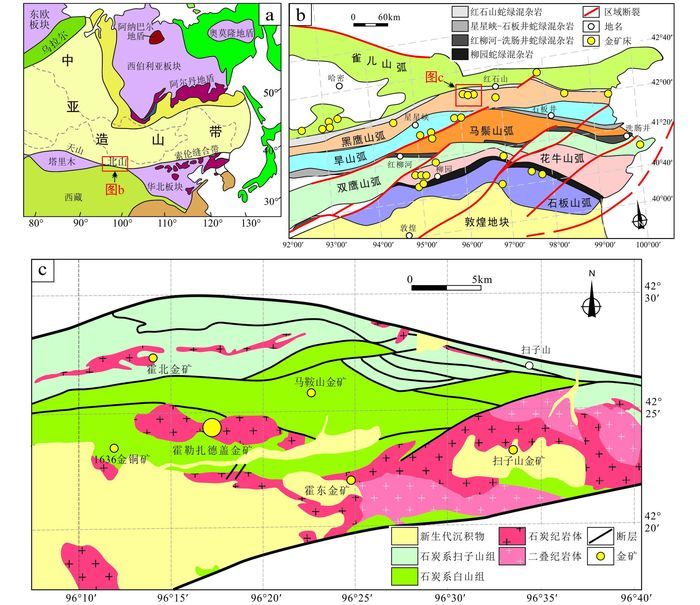
|
图 1 中亚造山带(图a,据Kröner et al., 2008) 、北山地区构造纲要(图b,据Xiao et al., 2010)和矿区地质简图(图c,据杨小三和刁海忠,2013修改) Fig. 1 Simplified tectonic sketch maps of Central Asian Orogenic Belt (a, modified after Kröner et al., 2008), Beishan Orogeny Belt (b, modified after Xiao et al., 2010) and geological map of the study area (c, modified after Yang and Diao, 2013) |
霍勒扎德盖金矿床位于黑鹰山弧内,区内以北东向和近东西向断裂为主(图 1b;Xiao et al., 2010),地层主要为石炭系钙碱性长英质火山沉积岩、碳酸盐岩和碎屑沉积岩(Xiao et al., 2010),岩浆活动以石炭纪和二叠纪的花岗质侵入岩为主(图 1c)。
矿区范围内构造发育,主要为近东西的主干断裂及北西向、北东向的次级断裂,次级断裂内常充填石英脉(图 1c)。矿区内出露地层为下石炭统白山组和第四系,其中白山组为一套弱变质的中酸性海相火山岩及碎屑沉积岩建造(崔惠文和陈祖伊,1996),岩性以绢云绿泥石英片岩为主,局部夹安山质凝灰岩。岩浆岩以石炭纪闪长岩类为主,呈岩基、岩株或岩脉产出(聂凤军等,2002) 。
3 矿床地质3.1 矿体及矿石特征霍勒扎德盖金矿床分为北东矿段和460矿段,目前探获100多条金矿体(杨小三和刁海忠,2013),矿体主要赋存于英云闪长岩断裂、节理裂隙内,以及白山组石英砂岩、绿泥石英片岩和安山质凝灰岩中(图 2、图 3a,b)。矿体以含金单石英脉为主,与围岩界限清晰,大部分矿化较稳定、连续,厚度0.14~5.46m,金平均品位9.92g/t (杨小三和刁海忠,2013) 。矿脉产状与矿区内断裂及次级断裂的产状总体一致:在460矿段中部和东部,矿脉走向以近东西向、北东向为主,西部以近南北向为主;北东矿段南部矿脉走向为北东向,北部为北西向;矿脉总体倾向北,倾角多60°~80°(图 2) 。
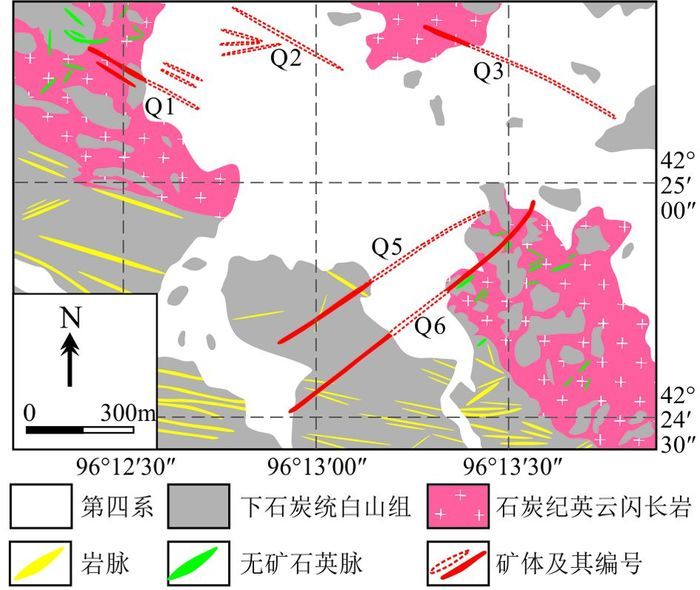
|
图 2 霍勒扎德盖金矿床北东矿段地质图(据陕西省地质矿产勘查开发局第六地质队,2010①) Fig. 2 Geological map of Beidong ore block in Herzhedegai gold deposit |
① 陕西省地质矿产勘查开发局第六地质队.2010.肃北县北东金矿详查地质报告
矿石类型为石英脉型;金属矿物以黄铁矿主(图 3c,g),次为黄铜矿(图 3g)、金银铅汞铋的碲化物(图 3h,i),少量闪锌矿、辉铜矿、孔雀石、褐铁矿和菱铁矿;非金属矿物以石英为主(图 3c),次为绿泥石、方解石,少量绿帘石、黝帘石,钻孔深部出现钠长石。矿石结构以他形、半自形或填隙结构为主;矿石构造以脉状为主,在无矿石英-方解石脉中可见梳状构造(图 3d)和晶洞构造,指示了成矿后的近地表张性环境(陈衍景,2010) 。
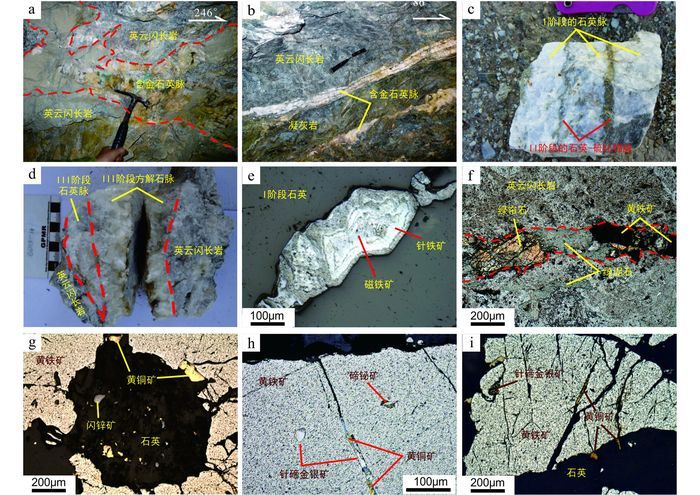
|
图 3 岩石、矿石及矿物的野外露头、手标本及镜下特征 (a)英云闪长岩中的含矿石英脉;(b)英云闪长岩和凝灰岩中的含矿石英脉;(c) Ⅱ阶段石英-硫化物脉切穿Ⅰ阶段石英脉;(d) Ⅲ阶段的梳状方解石;(e) Ⅰ阶段石英脉中的磁铁矿被针铁矿交代;(f) Ⅰ阶段绿帘石-黄铁矿-石英脉贯入英云闪长岩中,并被后期绿泥石交代;(g) Ⅱ阶段石英-多金属硫化物脉;(h) Ⅱ阶段沿裂隙产出的细脉状碲化物,其形成晚于黄铁矿及其内部大颗粒的碲化物;(i) Ⅱ阶段针碲金银矿沿裂隙产出 Fig. 3 Pictures of outcrop, hand specimen and microscope of the rocks, ores and minerals (a) auriferous quartz vein in tonalite; (b) auriferous quartz vein in tonaltie and tuff; (c) Ⅰ-stage quartz vein was crosscut by Ⅱ-stage quartz-sulfide vein; (d) Ⅲ-stage comb-like calcite vein; (e) magnetite was replaced by goethite in Ⅰ-stage quartz; (f) Ⅰ-stage epidote-pyrite-quartz vein in tonalite and was replaced by chlorite; (g) Ⅱ-stage quartz-polymetallic sulfide vein; (h) the fine telluride veins in the fracture were formed later than the Ⅱ-stage pyrite and coexisting granular tellurides; (i) sylvanite in cracks of Ⅱ-stage pyrite |
热液蚀变主要发育在含矿石英脉两侧的英云闪长岩和凝灰岩中,蚀变分带不明显。英云闪长岩中发育硅化、绢云母化、碳酸盐化,少量绿泥石化;凝灰岩中发育较强的绢云母化、绿泥石化、碳酸盐化。
根据含矿石英脉的野外产出和手标本特征(图 3a-d),将流体成矿过程从早到晚划分为Ⅰ、Ⅱ、Ⅲ三个阶段,分别形成(磁铁矿)-黄铁矿-石英脉、石英-多金属硫化物脉和石英-方解石脉。Ⅰ阶段的黄铁矿粒度较细,50~300μm,半自形-自形,多在乳白色粗大石英脉中呈稀疏浸染状分布,该阶段部分石英脉中可见磁铁矿(图 3e)。Ⅱ阶段的黄铁矿多呈脉状或团块状,粒度较粗,多大于1mm,半自形-自形,包含有大颗粒粒状碲化物(图 3h),普遍发生碎裂,被其他硫化物、碲化物或石英填充(图 3g-i)。
4 碲化物特征4.1 样品及实验方法研究对象为Ⅰ阶段黄铁矿-石英脉、Ⅱ阶段石英-多金属硫化物脉中的含硫化物样品,主要采自北东矿段2号矿体(BD13-17,BD13-18,BD13-19,BD13-20,BD13-21,BD13-22),少量采自3号矿体(BD13-05)和460矿段B229号矿体(46013-10,46013-12) 。将含硫化物的样品磨制成光片,利用矿相显微镜详细观察,圈定目标矿物,进行拍照,然后利用扫描电镜或电子探针进行分析。为对比、验证测试结果的可靠性及碲化物存在的普遍性,对不同样品在不同实验室进行了扫描电镜/能谱分析、电子探针等测试工作。
扫描电镜/能谱(SEM+EDS)测试工作分别在北京大学造山带与地壳演化教育部重点实验室和中国地质科学院成矿作用与资源评价国家重点实验室完成。前者的电镜型号为Quanta 650 FEG高分辨率多用途场发射扫描电子显微镜,分辨率1.4nm,加速电压12kV,最大放大倍数600万倍;能谱仪型号为牛津INCA X-MAX50 250+,点分析时工作电压为12kV,精度1.0nm。后者的电镜型号为德国Zeiss公司ULTRA PLUS场发射扫描电子显微镜,分辨率1.0nm,加速电压15kV,最大放大倍数100万倍;能谱仪型号为Oxford X-Max 20型电制冷能谱仪,工作电压15kV,精度1.0nm。标样分别为:Ag标样为Ag,Te和Hg标样为HgTe,Au标样为Au,Bi标样为Bi,Pb标样为PbF2。
电子探针测试分别在3家单位完成:北京大学造山带与地壳演化教育部重点实验室的仪器型号为JXA-8100,实验加速电压20kV,电流10nA,束斑直径2μm,所用标样为美国SPI公司53种矿物,分析误差小于0.01%,分析结果见表 1点1~点11;中国地质科学院矿产资源研究所电子探针室的测试仪器为JEOL_JXA_8230型电子探针,加速电压15kV,加速电流10nA,束斑直径5μm,所用标样为天然矿物或者合成金属国家标准,分析误差小于0.01%,分析结果见表 1点12~点26;中国地质大学地质过程与矿产资源国家重点实验室的测试仪器为EPMA-1720电子探针分析仪,加速电压为15kV,加速电流为10nA,束斑最小为1μm,所用标样为美国SPI公司标准样品,定量分析元素误差小于1.5%,总和误差小于2%,置信区间大于95%,分析结果见表 1点27~点44。
|
|
表 1 碲化物电子探针分析结果(wt%) Table 1 Compositions of tellurides detected by EMPA (wt%) |
扫描电镜观察、能谱点分析表明,霍勒扎德盖金矿床Ⅰ阶段黄铁矿-石英脉中未见碲化物,Ⅱ阶段石英-硫化物脉中普遍发育各类碲化物,且金/银矿物只以碲化物的形式存在,碲化物主要产出在黄铁矿内部或黄铁矿裂隙中,少数产在黄铜矿、石英内或其裂隙内。总体上,产在矿物内部的碲化物颗粒较大(>10μm),粒状无定向,而裂隙中的多呈长条状,粒度相对较小。根据元素组成,将该矿床的碲化物分为以下两大类。
4.2.1 Au-Ag碲化物该矿床的金银碲化物众多,包括碲金矿、斜方碲金矿、针碲金银矿、板碲金银矿、碲金银矿、γ相、碲银矿(图 4、图 5、表 1) 。
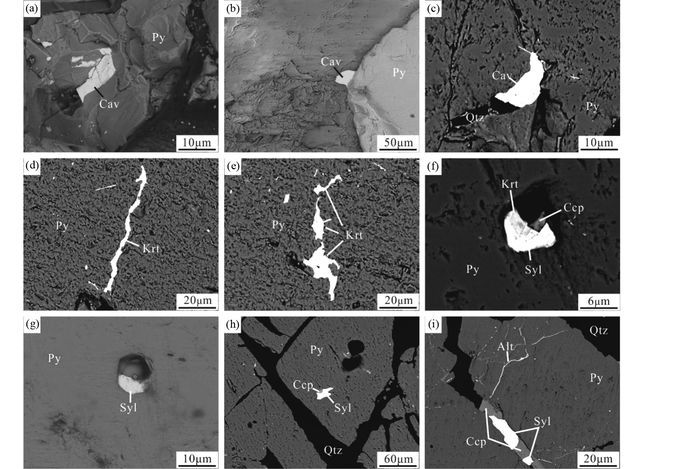
|
图 4 含金碲化物的产出特征 (a)黄铁矿中的碲金矿;(b)与黄铁矿接触的碲金矿;(c)黄铁矿裂隙中的碲金矿;(d)黄铁矿中呈细条状的斜方碲金矿;(e)黄铁矿中呈不规则状断续分布的斜方碲金矿;(f)黄铁矿中的斜方碲金矿-针碲金银矿-黄铜矿矿物组合;(g)黄铁矿孔洞中的针碲金银矿;(h)黄铁矿中的黄铜矿-针碲金银矿;(i)黄铁矿裂隙中的黄铜矿、针碲金银矿和碲铅矿.矿物缩写:Cav-碲金矿;Krt-斜方碲金矿;Ccp-黄铜矿;Py-黄铁矿;Qtz-石英;Syl-针碲金银矿;Alt-碲铅矿 Fig. 4 Occurrence of the gold-bearing tellurides (a) calaveritein pyrite; (b) coexisting calaverite and pyrite; (c) calaverite in cracks of pyrite; (d) thin krennerite vein in pyrite; (e) discontinuous krennerites in pyrite; (f) krennerite, sylvanite and chalcopyrite in pyrite; (g) sylvanite in pyrite; (h) sylvanite-chalcopyrite in pyrite; (i) chalcopyrite, sylvanite and altaite in fissures of pyrite. Abbreviations: Cav-calaverite; Krt-krennerite; Ccp-chalcopyrite; Py-pyrite; Qtz-quartz; Syl-sylvanite; Alt-altaite |

|
图 5 银碲化物、汞碲化物和铋碲化物的产出特征 (a)黄铁矿内的六方碲银矿;(b)Ⅱ3阶段γ相贯入Ⅱ2阶段银碲化物中;(c)黄铁矿边部及孔洞中的碲汞矿;(d)黄铜矿中的六方碲银矿、碲银矿和碲铅矿;(e)黄铁矿中的碲铋矿与针碲金银矿共生;(f)黄铁矿中碲金银矿与BiTe2.91共生;(g)黄铁矿裂隙中的碲汞矿、针碲金银矿和楚碲铋矿;(h)石英中的碲银矿与BiTe1.11;(i)黄铁矿裂隙中的楚碲铋矿和黄铜矿.矿物缩写:Tel-碲铋矿;Ts-楚碲铋矿;Hes-碲银矿;Col-碲汞矿;Stz-六方碲银矿;Alt-碲铅矿;Syl-针碲金银矿;Ptz-碲金银矿;Ccp-黄铜矿;Py-黄铁矿;Qtz-石英;γ-γ相 Fig. 5 Occurrence of silver-, mercury- and bismuth-bearing tellurides (a) stutzite in pyrite; (b) Ⅱ3-stage γ phase of crosscuts the Ⅱ2-stage silver-bearing tellurides; (c) coloradoite inclusion in pyrite; (d) stutzite, hessiteand altaite in chalcopyrite; (e) coexisting tellurobismuthite and sylvanite in pyrite; (f) coexisting BiTe2.91 and petzite in pyrite; (g) coloradoite, sylvanite and tsumoite in cracks of pyrite; (h) hessite and BiTe1.11 in quartz; (i) tsumoite and chalcopyrite in cracks of pyrite. Abbreviations: Tel-tellurobismuthite; Ts-tsumoite; Hes-hessite; Col-coloradoite; Stz-stutzite; Alt-altaite; Syl-sylvanite; Ptz-petzite; Ccp-chalcopyrite; Py-pyrite; Qtz-quartz; γ-γ phase |
碲金矿(AuTe2),主要赋存在黄铁矿中(图 4a),少量赋存在黄铁矿裂隙中(图 4c),发现于北东矿段2号和3号矿体中。碲含量为53.10%~59.69%(平均值56.13%),金含量为40.31%~46.90%(平均值43.08%),少量Ag元素2.16%~2.58%。
斜方碲金矿(AuAg3Te8),呈细脉状产在黄铁矿中(图 4d)或微裂隙中(图 4e),或与针碲金银矿、黄铜矿一起产在黄铁矿微裂隙中(图 4f);发现于北东矿段2号矿体和460矿段229号矿体。其中碲含量为54.22%~60.43%(平均值58.75%),金含量30.59%~38.01%(平均值34.12%),银含量为4.68%~6.45%(平均值5.96%);另含微量的Cu、Bi、Fe、S等元素。
针碲金银矿(AuAgTe4),为主要的含金银矿物,产在黄铁矿中(图 4g, h、图 5e),或产在黄铁矿裂隙中与铋碲化物(图 5g)或黄铜矿、石英共生(图 4i);在北东矿段2号、3号及460矿段229号矿体均有发现。其碲含量为55.44%~64.59%(平均值60.06%),银含量为6.72%~12.79%(平均值8.67%),金含量为23.45%~33.89%(平均值为28.62%);普遍含微量的S、Fe、Cu、Bi、Pb等元素。
碲金银矿(AuAg3Te2),产于黄铁矿中或与铋碲化物共生(图 5f),仅发现于2号矿体。其碲含量为26.89%~30.63%(平均值29.06%),金含量为27.44%~28.89%(平均值28.15%),银含量为40.14%~42.91%(平均值41.44%),含微量Bi、Fe、S等元素。
六方碲银矿(Ag5Te3),呈单颗粒分布在石英、黄铁矿、黄铜矿中(图 5a,d),仅发现于2号矿体。其碲含量为40.87%~40.89%(平均值为40.88%),银含量为59.11%~59.13%(平均值59.12%),含微量S、Pb、Cu、Fe等元素。
γ相(Ag1.89Te),产在石英中或贯入其他含银碲化物中(表 2点51, 52, 53、图 5b),仅见于2号矿体。碲含量为37.05%~38.66%,银含量为60.59%~61.34%,含微量Hg、Au、Cu、Fe、Bi、S等元素。
|
|
表 2 碲化物能谱分析结果(wt%) Table 2 Compositions of tellurides detected by EDS (wt%) |
碲银矿(Ag2Te),在黄铁矿或石英、黄铜矿(图 5d)中多呈单颗粒产出,个别与楚碲铋矿共生(图 5h),仅发现于北东矿段2号矿体中。其中碲含量为36.49%~38.06%(平均值37.12%),银含量为57.17%~63.51%(平均值为61.27%),含微量Bi、Au,Pb、S、Fe、Cu、Hg等元素。
板碲金银矿(AuAgTe2),产于黄铁矿中,仅发现于3号矿体中,碲含量为44.86%,银含量为20.18%,金含量为34.96%。
4.2.2 其他碲化物除了金银碲化物之外,在霍勒扎德盖金矿床还发现大量其他碲化物,包括碲汞矿、碲铅矿、碲铋矿、楚碲铋矿等。
碲汞矿 (HgTe),主要赋存于石英、黄铁矿内,或与针碲金银矿、楚碲铋矿产在黄铁矿裂隙中(图 5g),仅发现于2号矿体。其中碲含量为35.76%~41.16%(平均值38.29%),汞含量为58.84%~64.24%,平均值为61.39%,个别含微量Ag元素。
碲铅矿(PbTe),主要呈细脉状沿黄铁矿裂隙产出(图 4i),个别产在黄铁矿或黄铜矿中(图 5d);仅发现于2号矿体。其中碲含量为26.96%~39.57%(平均值36.12%),铅含量为54.48%~61.39%(平均值59.24%),含微量Ag、Cu、Ag等元素。
楚碲铋矿(BiTe),主要产在黄铁矿或黄铜矿中(图 5d),少量与针碲金银矿(图 5g)或黄铜矿(图 5i)共生产在黄铁矿裂隙中,或与碲银矿(图 5h)呈串珠状产在石英中;仅发现于2号矿体。其中碲含量为35.59%~39.28%(平均值37.67%),铋含量为45.37%~61.14%(平均值55.97%),含微量Fe、Ag、Au元素。
此外,在黄铁矿中还可见碲铋矿(Bi2Te3)、以及与碲金银矿共生的BiTe2.91(图 5e、表 2) 。
5 讨论5.1 矿物生成顺序与共生组合前文研究表明,在霍勒扎德盖金矿床热液成矿作用的Ⅰ阶段,形成少量黄铁矿和磁铁矿,未见碲化物;Ⅲ阶段形成石英-碳酸盐脉,无碲化物;在Ⅱ阶段,除了黄铁矿大量沉淀外,形成了众多碲化物;硫化物所占比例的相对减少暗示了成矿流体的硫逸度降低以及大规模富碲流体的加入。根据碲化物的产出特征,进一步将Ⅱ阶段从早到晚划为Ⅱ1、Ⅱ2和Ⅱ3三个亚阶段,并厘定主要碲化物和硫化物的生成顺序(图 6) 。
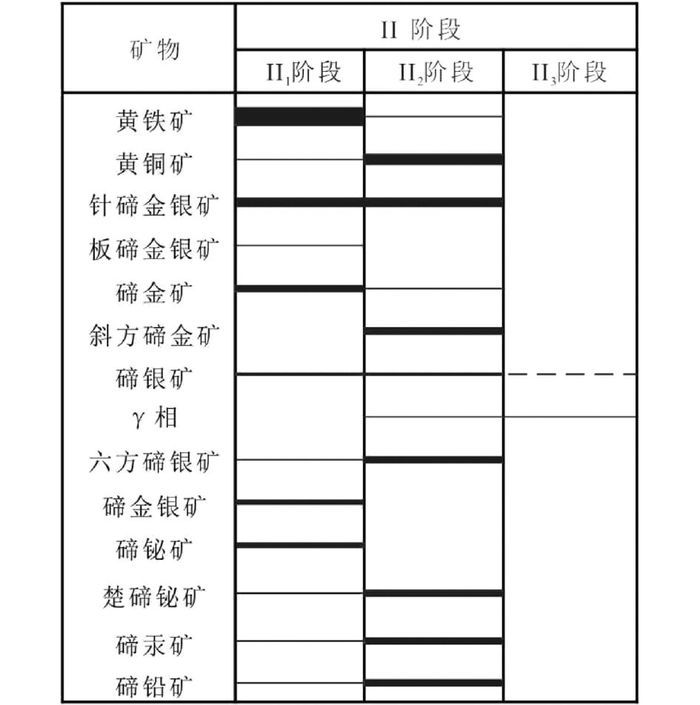
|
图 6 Ⅱ阶段碲化物和主要硫化物生成顺序 Fig. 6 Paragenetic sequence of the sulfides and tellurides in the Ⅱ-stage mineralization process |
Ⅱ1阶段形成的碲化物多呈自形-半自形产在黄铁矿中,其形成早于黄铁矿或与黄铁矿同时,此阶段形成的碲化物包括碲金矿(图 4a, b)、针碲金银矿(图 4g, h)、碲铋矿(图 5e)、板碲金银矿及少量碲银矿、六方碲银矿(图 5a)、楚碲铋矿(图 5d)、碲铅矿。
在Ⅱ2阶段,黄铁矿受到应力作用发生碎裂,形成的碲化物沿黄铁矿裂隙产出(图 3h,i),或偶见碲化物-黄铁矿细脉切穿Ⅰ阶段的粗粒石英脉,说明其形成与黄铁矿同时或晚于黄铁矿;此阶段形成的碲化物包括斜方碲金矿(图 4d-f)、楚碲铋矿(图 5d, i)、针碲金银矿(图 4i、图 5g)、碲铅矿(图 4i)以及少量碲金矿(图 4c)、γ相、碲银矿(图 5h)或碲汞矿(图 5g和e)。Ⅱ3阶段形成的碲化物种类较少,可见其切穿早阶段的碲化物,如Ⅱ3阶段的γ相穿插Ⅱ2阶段含银碲化物(Ag1.06~1.25Te)(图 5b)。
从形成碲化物的种类和数量来看,Ⅱ1和Ⅱ2阶段形成的碲化物占主导,且两亚阶段的碲化物种类相似,表明其沉淀间隔较短。从Ⅱ1到Ⅱ2阶段,主要碲化物(如针碲金银矿)中银的含量逐渐增加(表 1、表 2、图 7),且Ⅱ3阶段的γ相细脉切穿Ⅱ2阶段的含银碲化物(Ag1.06~1.25Te)(图 5b)。总的来看,随着成矿作用的进行,碲化物种类从富金的碲化物逐渐转变为富银、铅、汞的碲化物。
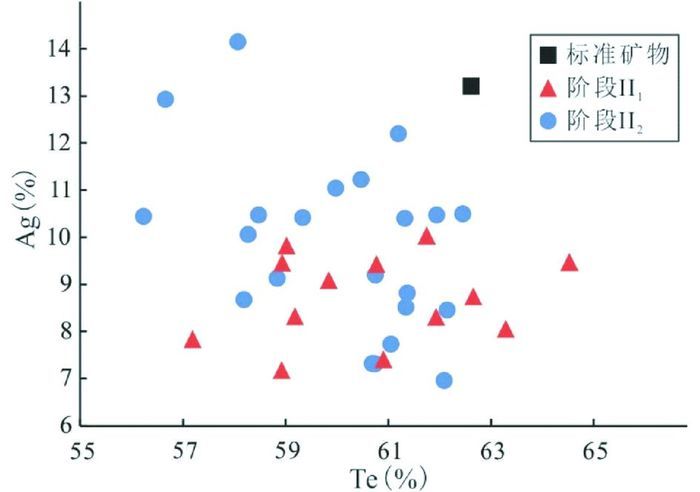
|
图 7 不同成矿阶段针碲金银矿Ag-Te含量协变图 Fig. 7 Ag-Te diagrams of sylvanite in different ore-forming stage |
作者对北东矿段7件样品、460矿段8件样品进行了流体包裹体测温,获得近400个测温数据,统计结果表明,该矿床Ⅰ阶段流体包裹体均一温度集中在300~320℃,Ⅱ阶段集中在220~260℃。基于此,本文根据前人(Stoffregen, 1987;Ahmad et al., 1987;Afifi et al., 1988a, b ;Simon and Essene, 1996) 提供的热力学参数和图解,并结合热力学软件HSC 6.0,建立300℃(对应于Ⅰ阶段)、250℃(对应于Ⅱ阶段)条件下的LogfTe2-LogfS2(图 8)和LogfS2-LogfO2关系图(图 9) 。在此基础上,分析霍勒扎德盖金矿床成矿过程中的氧逸度fO2、碲逸度fTe2和硫逸度fS2的变化。
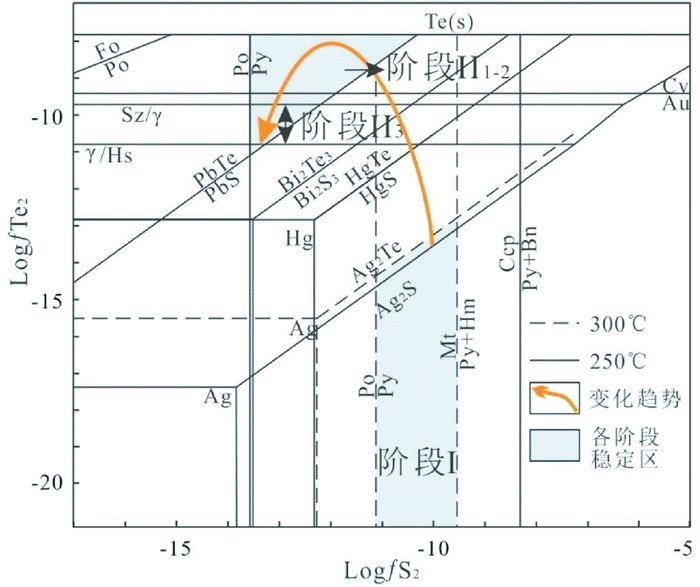
|
图 8 成矿过程中LogfTe2-LogfS2图(300℃时的相图据Afifi et al., 1988a, b ;250℃时的相图据热力学参数计算获得) Bn-斑铜矿;Ccp-黄铜矿;Cv-碲金矿;Fo-碲铁矿;Hm-赤铁矿;Hs-碲银矿;Mt-磁铁矿;Po-雌黄铁矿;Py-黄铁矿;Sz-六方碲银矿;γ-γ相 Fig. 8 Relative variations of Te2 and S2 fugacities with respect to sulfide and telluride at 300℃ (after Afifi et al., 1988a, b ) and 250℃ (calculated via thermodynamic parameters) Abbreviations: Bn-bornite; Ccp-chalcopyrite; Cv-calaverite; Fo-frohbergite; Hm-hematite; Hes-hessite; Mt-magnetite; Po-pyrrhotite; Py-pyrite; Stz-stutzite; γ-γ phase |
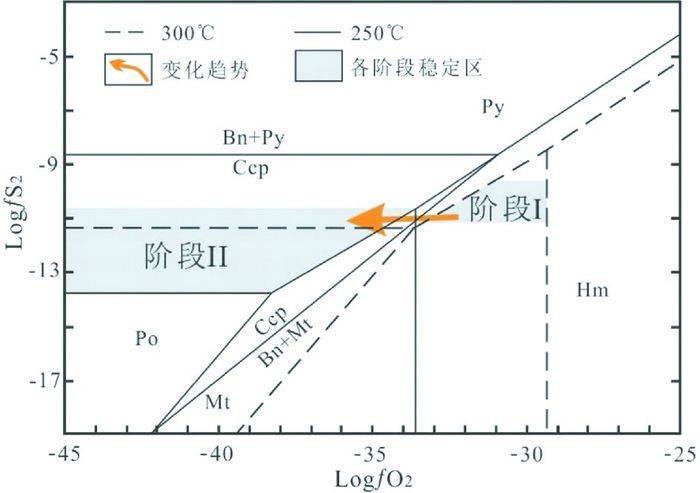
|
图 9 成矿过程中LogfS2-LogfO2图(250℃时的相图据Stoffregen, 1987;300℃时的相图根据热力学软件HSC获得) Bn-斑铜矿;Ccp-黄铜矿;Hm-赤铁矿;Mt-磁铁矿;Po-雌黄铁矿;Py-黄铁矿 Fig. 9 Relative variations of O2 and S2 fugacities with respect to sulfide and oxide at 250℃ (after Stoffregen, 1987) and 300℃ (calculated via thermodynamic software HSC) Abbreviations: Bn-bornite; Ccp-chalcopyrite Hm-hematite; Mt-magnitite; Po-pyrrhotite; Py-pyrite |
Ⅰ阶段无矿石英中出现了黄铁矿和少量磁铁矿,且没有碲化物、赤铁矿和磁黄铁矿,结合图 9推断300℃时成矿流体的LogfS2介于-11.1~-9.5;LogfTe2位于300℃时Ag2Te-AgS反应线之下,最大值为-12.8(图 8) ;结合图 9,推断出LogfO2介于-29.3~-33.3之间。这显示出早阶段流体具有较高氧逸度、较高硫逸度和较低碲逸度的特征。
Ⅱ阶段中Ⅱ1、Ⅱ2亚阶段形成碲化物组合类似,均出现了黄铁矿、碲汞矿、楚碲铋矿、碲铅矿、碲银矿、碲金矿、六方碲银矿,无磁黄铁矿、方铅矿和自然碲,据此判断250℃时流体的LogfS2值介于-13.5~-10.2,LogfTe2值位于-11.1~-7.8之间的三角形区域(图 8) 。Ⅱ3阶段只发现γ相,进而确定250℃时LogfTe2范围在-10.8~-9.7之间,而LogfS2上限为-6.1。Ⅱ阶段未发现磁铁矿和磁黄铁矿,存在黄铜矿和黄铁矿,从而确定该阶段LogfO2最大值为-33.0(图 9) 。因此,Ⅱ阶段热液成矿作用应发生在低硫逸度、低氧逸度和高碲逸度的条件下。
综上,从热液成矿Ⅰ阶段到Ⅱ阶段,成矿流体的氧逸度和硫逸度逐渐降低,碲逸度逐渐升高。
5.3 碲的来源及其意义碲是一种亲地核地幔、高挥发、水溶性差、易富集于硫化物的元素,同Au有着相似的地球化学属性(Afifi et al., 1988b;杜乐天等,1996;Cook et al., 2009b),在地幔中的含量(22×10-9)远高于地壳(3× 10-9~5 × 10-9)(Wedepohl, 1995;Talor and McLennan, 1995) 。此外,富碲的洋底沉积物(0.06×10-6~205×10-6,Hein et al., 2003) 的部分熔融可能是幔源碱性岩浆富碲的重要原因(Jensen and Barton, 2000) 。因此,碲化物出现更多的反映了幔源的贡献。多数与碲相关的热液矿床其成因也与深部岩浆活动或地幔有着密切的联系,这一认识在其他含碲化物矿床的研究中已经得到证实,例如,四川大水沟独立碲矿床,C、O、S、He、Ar等同位素信息表明成矿过程中有大量地幔物质的参与(Mao et al., 1995; 毛景文和魏家秀,2000) ;黑龙江三道弯子低硫型浅成低温金矿床伴生碲矿化,其He-Ar同位素显示Au、Ag、Te等成矿物质主要来自于地幔,地幔流体的加入与成矿密切相关(余宇星等,2012) ;罗马利亚Apuseni地区岩浆岩的年代学、岩石地球化学研究表明,洋壳俯冲后的岩石圈伸展引起受交代的岩石圈地幔上涌,导致了岩浆中Au和Te的富集,从而为Sacarimb金矿奠定了物质基础(Harris et al., 2013) 。
该矿床矿体产出受断裂控制,主要呈脉状产出,发育绢云母、钠长石和碳酸盐矿物,未见火山机构、硅质岩型矿石和明矾石-高岭石矿物组合,成矿流体不含CO2等特征表明其为低硫型浅成低温热液型(李雷,2015),或称之为亚浅成低温热液型矿床,以此来解释矿脉的形成深度与典型的浅成热液型矿床深部(<1500m)不一致且缺少典型热液蚀变矿物和结构的现象(Sillitoe, 2010; Lefort et al., 2011) 。据前人研究,与碲化物有关的浅成低温热液型矿床多为低硫型(Cook et al., 2009b),常与产在裂谷环境中的碱性岩浆有关(Richards, 2009;Cook et al., 2009b),成矿物质来源为幔源碱性岩浆(Richards, 2009;Harris et al., 2013) 或围岩(Hedenquist and Lowenstern, 1994) 。许保良等(2001) 的研究表明,北山地区发育有一套主体形成于二叠纪-三叠纪的富碱侵入体;而矿区含金石英脉中的热液锆石的LA-ICP-MS U-Pb 定年表明成矿发生在晚三叠世-早侏罗世;二者时间相近,说明该矿床与碱性岩关系密切。综合以上信息,认为该矿床金、碲的来源与地幔应具有较密切关系,即该矿床的碲化物显示了成矿物质深成、幔源的成因信息。
然而,不能排除矿区英云闪长岩提供金、碲成矿物质的可能,理由是:一,已发现的碲化物均产在英云闪长岩岩体内的石英-硫化物脉型矿石中,而来源于矿区白山组凝灰质片岩中的石英脉金银碲化物少见;二,据陕西省地质矿产勘查开发局第六地质队(2010),白山组地层中金元素平均含量2.2×10-9~2.8×10-9,与陆壳中金元素含量2.5×10-9(Wedepohl, 1995) 相近,而英云闪长岩中Au含量较高(平均含量为8.02×10-9),碲含量未知,有待进一步研究;三,矿石和围岩的铅同位素表明成矿物质来源与矿区内英云闪长岩有关(聂凤军等,2002) 。
6 结论(1) 霍勒扎德盖金矿床的流体成矿过程从早到晚划分为Ⅰ、Ⅱ、Ⅲ三个阶段,分别形成(磁铁矿)-黄铁矿-石英脉、石英-多金属硫化物脉和石英-方解石脉。Ⅰ、Ⅲ阶段中,未发现碲化物;Ⅱ阶段形成了众多碲化物,包括碲金矿、斜方碲金矿、针碲金银矿、碲金银矿、碲银矿、碲铅矿等,金银矿物仅以碲化物的形式存在。
(2) Ⅰ阶段流体的硫逸度(logfS2=-11.1~-9.5) 、氧逸度(logfO2=-33.3~-29.3) 较高,而碲逸度(logfTe2≤-12.8) 较低;Ⅱ阶段流体显示低硫逸度(logfS2=-13.5~-10.2) 、低氧逸度(logfO2≤-33.0) 、高碲逸度(logfTe2=-11.1~-7.8) 特征。
(3) 碲化物的发现揭示了矿床与深部幔源的紧密联系,但不能排除矿区英云闪长岩提供成矿物质的可能。
致谢 野外工作得到了肃北县北东矿业有限责任公司领导的大力支持;北京大学地球与空间科学学院刘树文教授、赖勇教授、张波副教授、李小犁博士,中国地质科学院矿床资源研究所李红艳博士和陈振宇博士在镜下鉴定、能谱测试和电子探针测试方面给予具体指导和帮忙;王钏屹参与了部分野外工作;三位审稿人对论文提出了宝贵的修改建议。谨此表示诚挚的谢意!| [] | Afifi AM, Kelly WC, Essene EJ. 1988a. Phase relations among tellurides, sulfides, and oxides: I, thermochemical data and calculated equilibria. Economic Geology, 83(2): 377–394. DOI:10.2113/gsecongeo.83.2.377 |
| [] | Afifi AM, Kelly WC, Essene EJ. 1988b. Phase relations among tellurides, sulfides, and oxides: Pt. Ⅱ, applications to telluride-bearing ore deposits. Economic Geology, 83(2): 395–404. |
| [] | Ahmad M, Solomon M, Walshe JL. 1987. Mineralogical and geochemical studies of the Emperor gold telluride deposit, Fiji. Economic Geology, 82(2): 345–370. DOI:10.2113/gsecongeo.82.2.345 |
| [] | Ao SJ, Xiao WJ, Han CM, Li XH, Qu JF, Zhang JE, Guo QQ, Tian ZH. 2012. Cambrian to Early Silurian ophiolite and accretionary processes in the Beishan collage, NW China: Implications for the architecture of the southern Altaids. Geological Magazine, 149(4): 606–625. DOI:10.1017/S0016756811000884 |
| [] | Bindi L, Rossell MD, Van Tendeloo G, Spry PG, Cipriani C. 2005. Inferred phase relations in part of the system Au-Ag-Te: An integrated analytical study of gold ore from the Golden Mile, Kalgoorlie, Australia. Mineralogy and Petrology, 83(3-4): 283–293. DOI:10.1007/s00710-004-0065-1 |
| [] | Chen YJ. 2010. On epizonogenism and genetic classification of hydrothermal deposits. Earth Science Frontiers, 17(2): 27–34. |
| [] | Chen YJ, Pirajno F, Wu G, Qi JP, Xiong XL. 2012. Epithermal deposits in North Xinjiang, NW China. International Journal of Earth Sciences, 101(4): 889–917. DOI:10.1007/s00531-011-0689-4 |
| [] | Cook NJ, Ciobanu CL. 2004. Bismuth tellurides and sulphosalts from the Larga hydrothermal system, Metaliferi Mts, Romania: Paragenesis and genetic significance. Mineralogical Magazine, 68(2): 301–321. DOI:10.1180/0026461046820188 |
| [] | Cook NJ, Ciobanu CL, Mao JW. 2009a. Textural control on gold distribution in As-free pyrite from the Dongping, Huangtuliang and Hougou gold deposits, North China Craton (Hebei Province, China). Chemical Geology, 264(1-4): 101–121. DOI:10.1016/j.chemgeo.2009.02.020 |
| [] | Cook NJ, Ciobanu CL, Spry PG, Voudouris P, the Participants of IGCP-486. 2009b. Understanding gold-(silver)-telluride-(selenide) mineral deposits. Episodes, 32(4): 249–263. |
| [] | Cooke DR, McPhail DC, Bloom MS. 1996. Epithermal gold mineralization, Acupan, Baguio District, Philippines: Geology, mineralization, alteration, and the thermochemical environment of ore deposition. Economic Geology, 91(2): 243–272. DOI:10.2113/gsecongeo.91.2.243 |
| [] | Cooke DR, McPhail DC. 2001. Epithermal Au-Ag-Te mineralization, Acupan, Baguio district, Philippines: Numerical simulations of mineral deposition. Economic Geology, 96(1): 109–131. |
| [] | Cui HW, Chen ZY. 1996. Gold Deposit Geology of Beishan Area, Gansu Province. Beijing: Geological Publishing House: 13-86. |
| [] | Du LT, Liu RX, Deng JF. 1996. Geochemistry of Mantle Fluids and Asthenosphere (Asthenoliths). Beijing: Geological Publishing House: 456-457. |
| [] | Gao S, Xu H, Zhang DS, Shao HN, Quan SL. 2015. Ore petrography and chemistry of the tellurides from the Dongping gold deposit, Hebei Province, China. Ore Geology Reviews, 64: 23–34. DOI:10.1016/j.oregeorev.2014.06.010 |
| [] | Han CM, Xiao WJ, Zhao GC, Su BX, Sakyi PA, Ao SJ, Wan B, Zhang JE, Zhang ZY. 2014. Late Paleozoic metallogenesis and evolution of the East Tianshan Orogenic Belt (NW China, Central Asia Orogenic Belt). Geology of Ore Deposits, 56(6): 493–512. DOI:10.1134/S1075701514060075 |
| [] | Harris CR, Pettke T, Heinrich CA, Rosu E, Woodland S, Fry B. 2013. Tethyan mantle metasomatism creates subduction geochemical signatures in non-arc Cu-Au-Te mineralizing magmas, Apuseni Mountains (Romania). Earth and Planetary Science Letters, 366: 122–136. DOI:10.1016/j.epsl.2013.01.035 |
| [] | Hedenquist AW, Lowenstern JB. 1994. The role of magmas in the formation of hydrothermal ore deposits. Nature, 370(6490): 519–527. DOI:10.1038/370519a0 |
| [] | Hein JR, Koschinsky A, Halliday AN. 2003. Global occurrence of tellurium-rich ferromanganese crusts and a model for the enrichment of tellurium. Geochimica et Cosmochimica Acta, 67(6): 1117–1127. DOI:10.1016/S0016-7037(02)01279-6 |
| [] | Jiang SH, Nie FJ, Lie Y. 2004. Gold deposits in Beishan Mountain, northwestern China. Resource Geology, 54(3): 325–340. DOI:10.1111/rge.2004.54.issue-3 |
| [] | Kröner A, Hegner E, Lehmann B, Heinhorst J, Wingate MTD, Liu DY, Ermelov P. 2008. Palaeozoic arc magmatism in the Central Asian Orogenic Belt of Kazakhstan: SHRIMP zircon ages and whole-rock Nd isotopic systematics. Journal of Asian Earth Sciences, 32(2-4): 118–130. DOI:10.1016/j.jseaes.2007.10.013 |
| [] | Lefort D, Hanley J, Guillong M. 2011. Subepithermal Au-Pd mineralization associated with an alkalic porphyry Cu-Au deposit, Mount Milligan, Quesnel Terrane, British Columbia, Canada. Economic Geology, 106(5): 781–808. DOI:10.2113/econgeo.106.5.781 |
| [] | Li L. 2015. Study of deposit geology and ore-forming fluid in 460 gold mine, Beishan area, Gansu Province, China. Beijing: Chinese University of Geoscience. |
| [] | Liu JL, Bai XD, Zhao SJ, Tran M, Zhang ZC, Zhao ZD, Zhao HB, Lu J. 2011. Geology of the Sandaowanzi telluride gold deposit of the northern Great Xing'an Range, NE China: Geochronology and tectonic controls. Journal of Asian Earth Sciences, 41(2): 107–118. DOI:10.1016/j.jseaes.2010.12.011 |
| [] | Liu JL, Zhao SJ, Cook NJ, Bai XD, Zhang ZC, Zhao ZD, Zhao HB, Lu J. 2013. Bonanza-grade accumulations of gold tellurides in the Early Cretaceous Sandaowanzi deposit, Northeast China. Ore Geology Reviews, 54: 110–126. DOI:10.1016/j.oregeorev.2013.03.003 |
| [] | Liu MQ, Wang JJ, Dai WJ. 2006. The U-Pb age of single-grained zircon from Maanshanbei granite in Hongshishan area of the Beishan orogenic belt, Gansu Province. Acta Petrologica et Mineralogica, 25(6): 473–479. |
| [] | Mao JW, Chen YC, Wang PA. 1995. Geology and geochemistry of the Dashuigou tellurium deposit, western Sichuan, China. International Geology Review, 37(6): 526–546. DOI:10.1080/00206819509465416 |
| [] | Mao JW, Wei JX. 2000. Helium and argon isotopic components of fluid inclusions and tracing to the source of metallogenic fluids in the Dashuigou tellurium deposit of Sichuan Province. Acta Geoscientia Sinica, 21(1): 58–61. |
| [] | Mao QG, Xiao WJ, Windley BF, Han CM, Qu JF, Ao SJ, Zhang JE, Guo QQ. 2012. The Liuyuan complex in the Beishan, NW China: A Carboniferous-Permian ophiolitic fore-arc sliver in the southern Altaids. Geological Magazine, 149(3): 483–506. DOI:10.1017/S0016756811000811 |
| [] | Nie FJ, Jiang SH, Bai DM, et al. 2002. Metallogenic Studies and Ore Prospecting in the Conjunction Area of Inner Mongolia Autonomous Region, Gansu Province and Xinjiang Uygur Autonomous Region (Beishan Mt. ), Northwest China. Beijing: Geological Publishing House: 55–373. |
| [] | Qi RR, Huang ZB, Jin X. 2006. Geochemical characteristics and tectonic implications of the Dashishan A-type granitic intrusive in Beishan area, Gansu Province. Acta Petrologica et Mineralogica, 25(2): 90–96. |
| [] | Richards JP. 2009. Postsubduction porphyry Cu-Au and epithermal Au deposits: Products of remelting of subduction-modified lithosphere. Geology, 37(3): 247–250. DOI:10.1130/G25451A.1 |
| [] | Sillitoe RH. 2010. Porphyry copper systems. Economic Geology, 105(1): 3–41. DOI:10.2113/gsecongeo.105.1.3 |
| [] | Simon G, Essene EJ. 1996. Phase relations among selenides, sulfides, tellurides, and oxides: Ⅰ, Thermodynamic properties and calculated equilibria. Economic Geology, 91(7): 1183–1208. DOI:10.2113/gsecongeo.91.7.1183 |
| [] | Song DF, Xiao WJ, Han CM, Tian ZH. 2013. Geochronological and geochemical study of gneiss-schist complexes and associated granitoids, Beishan Orogen, southern Altaids. International Geology Review, 55(14): 1705–1727. DOI:10.1080/00206814.2013.792515 |
| [] | Stoffregen RE. 1987. Genesis of acid-sulfate alteration and Au-Cu-Ag mineralization at Summitville, Colorado. Economic Geology, 82(6): 1575–1591. DOI:10.2113/gsecongeo.82.6.1575 |
| [] | Taylor SR, McLennan SM. 1995. The geochemical evolution of the continental crust. Reviews in Geophysics, 33: 241–265. DOI:10.1029/95RG00262 |
| [] | Tu GC. 2000. The preliminary study of the mechanism of tellurium deposits. Bulletin of Mineralogy, Petrology and Geochemistry, 19(4): 211–214. |
| [] | Wedepohl KH. 1995. The composition of the continental crust. Geochimica et cosmochimica Acta, 59(7): 1217–1232. DOI:10.1016/0016-7037(95)00038-2 |
| [] | Wu YS, Chen YJ, Zhou KF. 2017. Mo deposits in Northwest China: Geology, geochemistry, geochronology and tectonic setting. Ore Geology Reviews, 81(2): 641–671. |
| [] | Xiao WJ, Mao QG, Windley BF, Han CM, Qu JF, Zhang JE, Ao SJ, Guo QQ, Cleven NR, Lin SF, Shan YH, Li JL. 2010. Paleozoic multiple accretionary and collisional processes of the Beishan orogenic collage. American Journal of Science, 310(10): 1553–1594. DOI:10.2475/10.2010.12 |
| [] | Xu BL, Yan GH, Lu FX, Zou TR, Tong Y, Cai JH, Liu CX, Zhang HF. 2001. Petrology of rich-alkaline and alkaline intrusive complexes in Beishan-Alxa region. Acta Petrologia et Mineralogica, 20(3): 263–272. |
| [] | Xu WG, Fan HR, Hu FF, Santosh M, Yang KF, Lan TG, Wen BJ. 2014. Gold mineralization in the Guilaizhuang deposit, southwestern Shandong Province, China: Insights from phase relations among sulfides, tellurides, selenides and oxides. Ore Geology Reviews, 56: 276–291. DOI:10.1016/j.oregeorev.2013.06.010 |
| [] | Yang XS, Xi HZ. 2013. Geology and prognosis of 460 gold deposit in Beishan area of Gansu Province. Science & Technology Information(13): 425–426. |
| [] | Yu YX, Xu H, Wu XK, Yang LJ, Tian Z, Gao S, Wang QS. 2012. Characteristics of the Au-Ag-Te minerals and its ore-forming fluids in Sandaowanzi gold deposit, Heilongjiang Province. Acta Petrologica Sinica, 28(1): 345–356. |
| [] | Zhai DG, Liu JJ. 2014. Gold-telluride-sulfide association in the Sandaowanzi epithermal Au-Ag-Te deposit, NE China: Implications for phase equilibrium and physicochemical conditions. Mineralogy and Petrology, 108(6): 853–871. DOI:10.1007/s00710-014-0334-6 |
| [] | Zhou QF, Li SR, Chen HY, Song YB, Zhang YQ, Zhang XB, Cui JC. 2011. Discovery and geological significance of telluride minerals in the Yinggezhuang gold deposit, Rushan, Jiaodong. Acta Petrologica Sinica, 27(6): 1847–1856. |
| [] | 陈衍景. 2010. 初论浅成作用和热液矿床成因分类. 地学前缘, 17(2): 27–34. |
| [] | 崔惠文, 陈祖伊. 1996. 甘肃北山地区金矿地质. 北京: 地质出版社: 13-86. |
| [] | 杜乐天, 刘若新, 邓晋福. 1996. 地幔流体与软流层(体)地球化学. 北京: 地质出版社: 456-457. |
| [] | 李雷. 2015. 甘肃北山地区460金矿矿床地质及成矿流体研究. 硕士学位论文. 北京:中国地质大学 |
| [] | 刘明强, 王建军, 代文军. 2006. 甘肃北山红石山地区马鞍山北花岗岩体的单颗粒锆石U-Pb年龄及地质意义. 岩石矿物学杂志, 25(6): 473–479. |
| [] | 毛景文, 魏家秀. 2000. 大水沟碲矿床流体包裹体的He、Ar同位素组成及其示踪成矿流体的来源. 地球学报, 21(1): 58–61. |
| [] | 聂凤军, 江思宏, 白大明, 等. 2002. 北山地区金属矿床成矿规律及找矿方向. 北京: 地质出版社: 55-373. |
| [] | 齐瑞荣, 黄增保, 金霞. 2006. 甘肃北山大石山A型花岗岩体的地球化学特征及构造意义. 岩石矿物学杂志, 25(2): 90–96. |
| [] | 涂光炽. 2000. 初论碲的成矿问题. 矿物岩石地球化学通报, 19(4): 211–214. |
| [] | 许保良, 阎国翰, 路凤香, 邹天仁, 童英, 蔡剑辉, 刘楚雄, 张华峰. 2001. 北山-阿拉善地区二叠-三叠纪富碱侵入岩的岩石学特征. 岩石矿物学杂志, 20(3): 263–272. |
| [] | 杨小三, 刁海忠. 2013. 甘肃北山460金矿区矿床地质特征及外围找矿方向探讨. 科技信息(13): 425–426. DOI:10.3969/j.issn.1001-9960.2013.13.340 |
| [] | 余宇星, 许虹, 吴祥珂, 杨利军, 田竹, 高燊, 王秋舒. 2012. 黑龙江三道湾子金矿Au-Ag-Te系列矿物特征及其成矿流体. 岩石学报, 28(1): 345–356. |
| [] | 周起凤, 李胜荣, 陈海燕, 宋玉波, 张运强, 张秀宝, 崔举超. 2011. 胶东乳山英格庄金矿碲化物的发现及其意义. 岩石学报, 27(6): 1847–1856. |
 2017, Vol. 33
2017, Vol. 33




